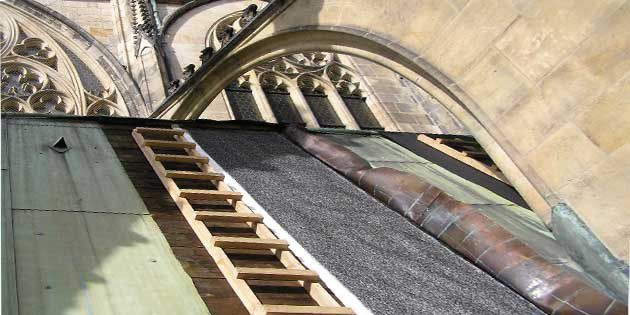XIV Century ST. Wenceslas Chapel Is Now Protected With Dupont™ Tyvek® Metal Advanced Membrane
Case Study

St. Vitus Cathedral: installation of the DuPont™ Tyvek® Metal membrane on the St. Wenceslas Chapel roof; photo DuPont™ Tyvek®, all rights reserved.
The renewal of historical monuments always require great care and respect. Each monument combines an invaluable historical aspect, a unique architectural solutions and is the materialization of the soul and the spirit of a country. DuPont™ Tyvek® Metal had the honour of being used for an extremely important and challenging renewal projects of this kind: the reconstruction of the roof of St. Wenceslas Chapel at St. Vitus Cathedral.
In May of 2011, the reconstruction of the copper roof above St. Wenceslas Chapel was completed. Following a careful market research, the DuPont™Tyvek® Metal advanced membrane was chosen for increased protection. First, the original copper plates were removed and, before placing of a new, artificially patined copper roof, the DuPont™ Tyvek® Metal vapour open membrane was installed on timber formwork into the roof structure. The purpose of the membrane was to increase weather protection of the chapel and prevent condensed moisture from penetrating into the roof structure.
St. Vitus Cathedral is the greatest and most significant church in Prague. In addition to divine services, memorable coronations of Czech kings and queens have been held here since its opening. It is at this place where remains of saint patrons, monarchs, archbishops and prominent aristocrats of the Czech lands are resting.
The construction of this Gothic monument started as early as the middle of the XIV century, but the whole area was not completed until 1929. A choir with choir chapels and a supporting system, a part of the transverse aisle, southern vestibule and a big tower have come down from the Medieval Ages. The main aisle, narrow side aisles with lateral chapels and the western front with two towers represent the neo-Gothic era of the cathedral. St. Wenceslas Chapel is partly located in the southern branch of the transverse aisle.
Splendidly decorated and uniquely designed, the chapel stands out as the focal point of the cathedral, encasing the grave of the most significant patron of the country. Gemstone wall facing and Passion cycle wall paintings are part of the original chapel decoration coming from the XIV century. Like all historical monuments, St. Vitus Cathedral is subject to ageing and has always required more or less extensive restorations since its first construction in the XIV century.
